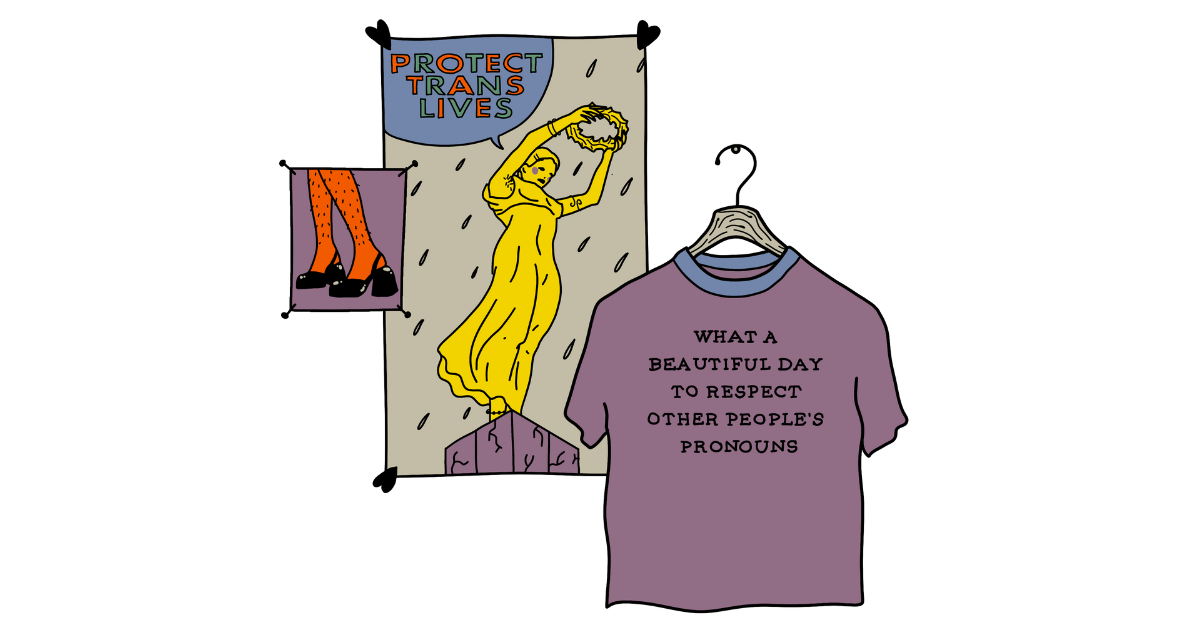
After Nemo, the non-binary Swiss singer won Eurovision, confusion arose in the Luxembourgish media about how to refer to them. They were alternately addressed as “he” and “she” in a Luxembourgish-language article, sparking controversy.
While this was an understandable attempt given the lack of guidelines, languages evolve, and solutions can be developed. Neopronouns take some getting used to if one does not routinely have to use them, but ultimately it is the kind thing to do; ideally, one would just ask the person what pronouns they go by and stick to those.
Non-binary identity is a relatively new discussion topic when it comes to language use in Luxembourg and beyond. Many countries are currently grappling with grammar and vocabulary adaptations. For those who predominantly speak English in their daily lives, the neutral pronoun “they” seems to work well for most non-binary individuals — it is simple and reportedly affirming. In English, verbs should remain singular when used with a person’s name, but plural when used with “they”. (Charlie is our new friend. They are a non-binary person.) Although not yet common use, “they”(or “dey”/ borrowed from English) can serve as alternatives for the gendered pronouns “he” and “she”, even in German and Luxembourgish.
Additionally, English is a gender-neutral language, so most job roles and titles will often have an easy ungendered replacement (such as spouse/ parent/ sibling/ cousin/ doctor/ flight attendant). Such is not the case for all the official languages of Luxembourg, which are gendered: French, German, and Luxembourgish. These languages constantly require the reiteration of people’s gender in multiple forms.
For this article, we reached out to a few non-binary locals and to mindful allies to investigate how they use pronouns across the three languages, what they like and prefer, and what solutions they envision for the future (also concerning neo-pronouns and ungendered language).
In Luxembourgish, articles denote gender for people and objects, as Marielle, a Luxembourgish teacher, explained. Masculine articles are “den/de”, or “en/ e” (the N stays only if the noun begins with one of the letters UNITEDZOHAY), while feminine or neutral articles are “d’/eng” and “en/e”, respectively. When referring to people, the article before the person’s name indicates their gender: d’Anna (feminine; with the neutral pronoun “d'”) and de Ben (masculine). This creates challenges for non-binary individuals, who may prefer gender-neutral options.
Marielle suggests dropping these introductory articles before names. While it may be unusual for most Luxembourgish natives, it is reportedly standard use for people in the Eislek region or the Luxembourgish Ardennes. This is the form Marielle normally uses at the moment when referring to non-binary people, e.g. Sam Smith kënnt demnächst op Lëtzebuerg (EN: Sam Smith will be coming to Luxembourg soon.”)
For possessive pronouns (his/hers/theirs), Luxembourgish uses neutral forms like “seng” for both the masculine and the feminine forms (as feminine pronouns are neutral). For example: “Ech ginn op (dem) Sam Smith säi Concert. (no article). Seng Show ass flott.” (EN: I am going to Sam Smith’s concert. Their show is great.)
Another gendered feature is the special polite form “Si”, used to refer to women previously mentioned as “Madam” (for teachers or older women in positions of authority). “Hatt” refers to female peers we previously mentioned by name, while “si” also serves as the plural form for all genders.
Five Options for Non-Binary Reference in Luxembourgish:
- Use the person’s preferred pronouns (of course!)
- Repeat their name instead of using pronouns
- Use the plural form “si”
- Borrow “they” (dey) from English
- Create a new pronoun
According to Marielle, “Luxembourgers should not complain if we invent/introduce a new pronoun, because the hatt-si difference was also never an issue for native speakers. People who learn Luxembourgish struggle quite a lot with this.”
In German, gender-inclusive forms can be marked in writing with *in, :in, _in or “Innen” can be used, as in: Kund*in, Kund:in, Kund_in or Kund*innen for more gender-inclusive language. Emerging neopronouns include xier/xieser/xiem/xien and dey/denen/deren, though German’s complex grammar poses challenges. German is trickier for pronoun use due to its complex case system, and it requires many more pronoun forms than English. English gets by with two gender-dependent personal pronouns (he/she) and one gender-dependent possessive pronoun (his/her). Relative pronouns in English do not adapt to gender, simplifying the matter (ex. This is the girl whom I like. She is the one who organised the event.) In German, the currently “easiest” option for inclusive pronouns would be to avoid using pronouns by repeating the name, as mentioned previously for Luxembourgish*. This is also Nemo’s preference in German. However, this may create relatively clunky sentences (“Nemo singt gerne, da Nemo sich gerne frei ausdrückt.” EN: Nemo likes to sing, as Nemo likes to express themselves freely.) Using “es” (neutral “it”) is generally avoided due to its demeaning tone when applied to people.
We also spoke to Seli, a non-binary, German native speaker, who studied and is now working in Luxembourg. They told us more about how they experience the official languages in the Grand Duchy.
In German, Seli prefers the neopronouns “dey/denen/deren”, but acknowledges that many often struggle with these forms. They also use gender-neutral formulations when they speak, and they prefer it when people address them as such. Seli uses resources like geschicktgendern.de, which they deem really useful to find gender-neutral alternatives (ex. (der) Lehrer -> Lehrperson; Lehrkraft, EN: teacher)**. In formal situations, Seli reluctantly accepts being addressed as Frau + surname but they hope for more inclusive pronoun options across languages, like “Mx” in English. Furthermore, they yearn for an official gender-neutral pronoun in all 3 languages.
Seli is learning Luxembourgish but they find it “very binary” and lacking gender-neutral options, which makes it hard for them to feel fully seen. “The lack of gender neutrality makes me sad because I actually really like the language and I use it often in my daily life. Also, it’s hard to be misgendered constantly and to not be able to tell people how to address me correctly due to the lack of options,” Seli remarked.
In French, which they do not use frequently, Seli favours the neopronoun “iel” (which combines the masculine “il” and feminine “elle” to express non-binary identity). They find it easier to use gender-neutral language in French in written rather than spoken form. Some examples are: “La∙le directeur∙ice” or “Les étudiant∙es sont actif∙ves”.
Overall, Seli believes language is evolving, and that people can get better at using inclusive language by practicing and staying open-minded. “However, there should always be room for different neopronouns to exist, since not every non-binary/gender non-conforming person feels seen by the same gender-neutral pronoun,” they added.
Seli also emphasised the need for wider education on this topic: “I wish that (…) gender-neutral language and pronouns were taught to the general population, so people could have better knowledge on how to use it and why it matters. As a non-binary person, it is exhausting to often have to educate a lot of people by yourself since you are the first person to bring them in contact with this topic,” they added.
We also spoke to Clara, who mainly communicates in English and French. They start off by saying that they do not necessarily feel offended when someone refers to them as “she” (given that Clara is feminine/female presenting), just that it feels strange. This is also because Clara is not yet fully sure which “box” they feel comfortable in. To them, it is also a question of energy: “I don’t think I have the energy to correct people on my pronouns so putting all of them out there is also me being scared of having to be too much out there. Maybe if I had more confidence in who I am and less fear of other’s judgment I would be more assertive in my everyday life.” Often, people do not have an interest in this topic and so they do not do research on their own. Learning about neo-pronouns from a young age at school could help with this.
In French, Clara tells us, things are much more complicated due to it being a gendered language. Given that they use French in mostly unaccepting environments, they generally go with feminine gendered words. If they felt safer, they would use the pronoun “iel”, as Seli mentioned earlier. However, this does not solve the issue with gender markers throughout the language and would require a full “revamp” of the entire grammar. This is a major source of frustration for non-binary individuals; they must frequently explain their pronouns to those who are uninformed.
Clara said she does not “mind” neo-pronouns. They would use them if asked. They would not use them to refer to themselves, mostly because they already have a hard time asserting “they/them” in their day-to-day life, so that is way out of their comfort zone.
The final person we spoke to is Mara, who was recently interviewed by RTL, alongside their friend Bellamy, on non-binary identities. Mara tells us how they, primarily in Luxembourgish, like to communicate in regards to gender, i.e., they like it when people use the expression “déi Persoun” as it is gender neutral and the pronoun “si” in reference to “déi Persoun” can be used in a gender-neutral way, too. Alternatively, they import expressions from English and apply them to Luxembourgish. So, “they/them” would turn into “dey / dem” as some folks do it with German. In addition, the “Gender Sternchen” as mentioned earlier, can also be used in Luxembourgish. This makes intuitive sense, as Luxembourgish is a Germanic language.
Mara mentions that few people in Luxembourg respect their pronoun choices and still refer to them as a woman. They wish that at least in feminist/queer spaces, people would use the correct pronouns without having to be reminded not to misgender them.
The solution here is for everyone to introduce themselves with their preferred pronouns so that trans and non-binary folks do not feel left out or like the odd ones out.
Inclusive language is a work in progress, but embracing this change can foster respect and recognition for non-binary individuals in Luxembourg’s multilingual context. And it can also help our non-binary friends feel more seen and acknowledged.
Additional Contributor: Pierre Balthasar is a 29-year-old PhD candidate at the University of Luxembourg for Luxembourgish Studies. His passion for writing articles (so far for FORUM) on politics, social justice, and his own personal involvement in the local, Luxembourgish politics and queer scene has set him in touch with Otilia. They love talking about all things queer together and so the question regarding pronouns has naturally come up as well as writing about it, given that she used to be a journalist.




